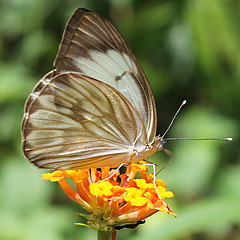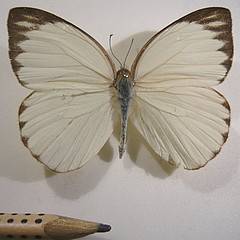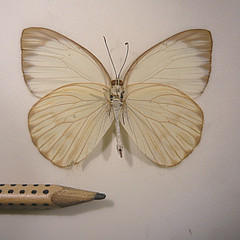Ascia monuste (Linnaeus, 1764)
Great Southern White
| Papilio monuste (Linnaeus, 1764) |
It is a common species of great activity in sunny places. Are small butterflies with colors from white to yellow and delicate and graceful flight. Are easily reproduced and used as attraction in butterfly gardens.
The high reproductive rate also has importance in the economic aspect as attacking cultivated plants. In this species At least seven subspecies are described, and particularly in Brazil A. monuste orseis is one important pest (Liu, 2005).
Aspects of reproductive biology, cannibalism among immature and food preference can be found in: ; Barros & Zucoloto, 1999; Barros-Bellanda & Zucoloto, 2005 Braga & Zucoloto, 2004; Felipe & Zucoloto, 1993.
Argentina; Barbados; Belize; Brasil; Colombia; Costa Rica; Cuba; Curaçao; Guyana; Jamaica; México; Panamá; Perú; Puerto Rico; Quisqueya; Suriname; Trinidad and Tobago; Uruguay; Venezuela
Occurs throughout the year
Male and female sucking on flowers
Host-plant recorded in the Brasil compiled by Beccaloni et al. (2008).
Capparaceae: Capparis cynophallophora, Capparis speciosa, Capparis tweediana, Crateva tapia, unidentified species.
Cruciferae: Brassica napus, Brassica nigra, Brassica oleraceae, Brassica rapa, Raphanus raphanistrum, Rorippa nasturtium-aquaticum.
Leguminosae - Caesalpinioideae: Cassia spp.
Tropaeolaceae: Tropaeolum majus
Besides these species, are registered in another countries: Alliaceae, Bataceae, Euphorbiaceae, Marantaceae, Sapindaceae.
white, yellow
river bank, urban, anthropogenic, forest edge
- Barros H.C.H., Zucoloto F.S. (1999):
- Performance and host preference of Ascia monuste (Lepidoptera, Pieridae). Journal of Insect Phisiology. 45: 7-14
- Barros-Bellanda H.C.H., Zucoloto F.S. (2005):
- Egg cannibalism in Ascia monuste in the field; opportunistic, preferencial and very frequent. Journal Ethology. 23: 133-138
- Zago-Braga R.C., Zucoloto F.S. (2004):
- Cannibalism studies on eggs and newly hatched caterpillars in a wild population of Ascia monuste (Godart) (Lepidoptera, Pieridae). Revista Brasileira de entomologia. 48(3): 415-420






